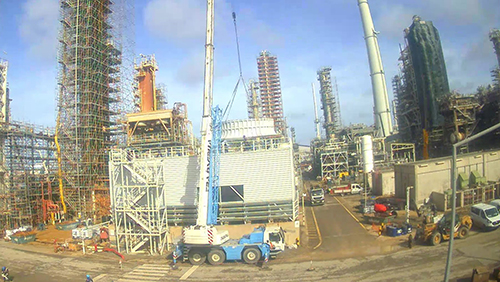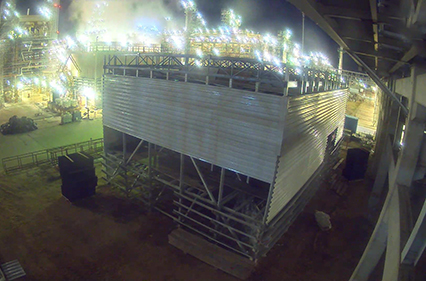To assist with a plant upgrade, one of the largest refineries in Europe selected and presented SPIG with a bold challenge: the comprehensive disassembly and reassembly of a SPIG fiber reinforced polymer (FRP) Cooling Tower (CT) comprising two cells within a tight 21-day timeframe to synchronize with a planned shutdown.
SPIG’s team engineered the execution plan that required both speed and precision.
Construction commenced on the two-cell CT, built in a dedicated area alongside the original tower that remained stationary during the project. The new tower measured 12×24 m2 and reached a height of 14 m.
SPIG pre-assembled 90% of the cooling tower off the basin before positioning it in place of the old cooling system. The construction team built a metal frame around the roof of the new tower to enhance stability and ease the subsequent crane lift.

The project stayed on schedule despite adverse weather conditions. It was crucial to reach the lifting day with all demolition work completed. Having fully assembled the tower outdoors, it was essential to adhere strictly to all tolerances specified in the assembly drawings to avoid issues with the supporting pillars. Many tasks needed to be carefully sequenced and planned, including the connection of the customer’s riser flange to the new header.
As the 21-day countdown continued, the focus transitioned from construction to the dismantling of the existing wooden tower. Days were dedicated to taking down the existing wooden cooling tower and then preparing the grounds for the installation of the new cooling system.
With just days remaining, SPIG engineers seamlessly shifted from deconstruction to the assembly and lift of the new CT. Weighing 30 tons, the new CT was hoisted into position on pillars standing 3.5 m tall. The final components to be installed included pre-assembled fan stacks, pre-assembled mechanical groups and the stairway.
The unique installation procedure devised by SPIG engineers not only achieved its objectives but also resulted in a time savings of 50% compared to the standard practice of dismantling the old CT and subsequently assembling the new components to erect the entire CT in place immediately after disassembly. This efficiency underscores the effectiveness of our tailored approach in meeting stringent timelines without compromising precision.
This project, which required expertise, attention to detail, innovation and teamwork was completed on schedule and adhered to all safety measures, ensuring a secure and compliant execution throughout the entire process.

